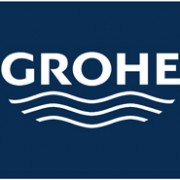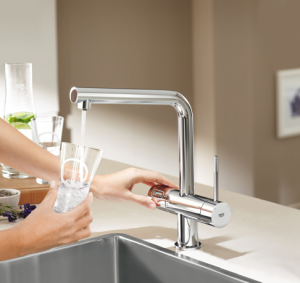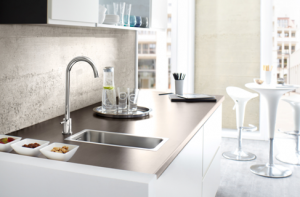Sustainable and economical – GROHE Blue® in office kitchens
New study shows that the carbon footprint of GROHE Blue® is significantly smaller compared to bottled water
When it comes to fitting out their premises, today’s enterprises attach importance not only to functionality, cost-efficiency and convenience but increasingly also to sustainability. Green buildings are an excellent advertisement for businesses seeking to demonstrate their environmental values to employees, business partners and customers. Local planning regulations, too, are increasingly geared towards eco-friendly construction and interior design. Minimising the carbon footprint is consequently an integral element of any forward-looking company’s sustainability policy. A recent study carried out by the Production and Logistics Chair of Georg-August University in Göttingen in cooperation with Grohe AG compared the carbon footprint of GROHE Blue® with that of bottled mineral water. The result: the greenhouse gas emissions associated with the GROHE Blue® water system are much lower. This clear benefit for the environment goes hand in hand with greater efficiency, cost reductions and comfort.
Scientifically proven sustainability
The aim of the study was to calculate the greenhouse gas emissions of GROHE Blue® and to put them in relation to bottled water. Between July and November 2013, the scientists of Göttingen University compared the carbon footprint of one litre of water tapped from the GROHE Blue® system with the footprint of one litre of bottled water. The scenario was based on the assumption of 30 users per day who drink one litre of bottled water on 220 days of the year over a period of five years. The calculation of the carbon footprint covered all five lifecycles of GROHE Blue® and of bottled mineral water, which range from production and transport of the raw materials as well as transport of the finished product to consumption and disposal. Another factor in the analysis was the geographic distribution of GROHE Blue® across the main output markets, Germany, France and the USA. The assumed consumption was 40 percent sparkling, 30 percent medium and 30 percent still water.
Based on these data, the scientists calculated green house gas emissions of 17.96 g CO2-eq/litre for GROHE Blue®. This is an impressive result, as the emissions are much lower than those of bottled mineral water, which range from 70 to 600 g CO2-eq/litre, depending on the type of packaging and the place of origin. Since GROHE Blue® does not need to be bottled and transported over long distances, it is clearly superior to bottled water in terms of sustainability. The study also shows that the values achieved by GROHE Blue® are even lower than those of conventional water dispensers, which range from about 35 to 50 g CO2-eq/litre. This means that GROHE Blue® allows users to save greenhouse gas emissions of at least 25 to 50 percent.
A versatile device for modern office kitchens
But this smart water system has even more to offer. The fact that it supplies filtered and chilled water in three different variants – sparkling, medium and still – directly from the special kitchen faucet means that the many different users in an organisation can enjoy their preferred type of water at any time. This saves the time and logistic effort of ordering sufficient quantities of the different types of bottled water, placing them in the various offices, storing them and recycling the bottles. Whether used as a regular refreshment for employees or placed in carafes on the conference table – freshly tapped, well-tasting water is always at hand thanks to the environmentally friendly and comfortable GROHE Blue® system.
GROHE Blue Minta
GROHE Blue Mono



